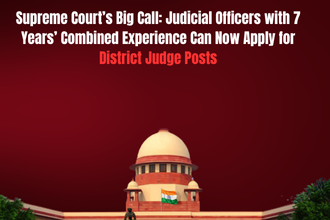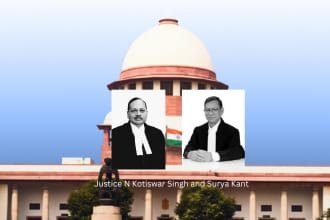In a major step toward inclusivity and fairness in the judicial recruitment process, the Supreme Court of India has ruled that judicial officers with a combined experience of seven years as advocates and judges can apply directly for appointment as District Judges.
This might sound technical, but it’s a big deal — not just for those in the judicial service but also for how we interpret eligibility, opportunity, and merit within India’s justice system.
A Turning Point After Years of Confusion
For decades, Article 233 of the Constitution has guided how District Judges are appointed. It says that anyone “not already in service” and who has at least seven years of experience as an advocate or pleader can be appointed as a District Judge.
That wording — “not already in service” — became the source of endless debate. Could someone who had been a lawyer for years, then joined the judicial service, still apply for a District Judge post under the “Bar quota”?
In 2020, the Supreme Court in Dheeraj Mor v. High Court of Delhi said no. The judgment held that a person serving as a civil judge could not apply under the quota meant for practising advocates. Once you joined the judiciary, you were out of the “advocate” category.
This effectively split the paths of lawyers and judges. Advocates could aim for direct recruitment; judicial officers could only climb up slowly through promotion.
The new ruling changes that completely.
What the Supreme Court Said
A five-judge Constitution Bench headed by Chief Justice BR Gavai revisited the entire issue in the case of Rejanish K.V. v. K. Deepa.
Rejanish had practised as a lawyer for more than seven years before joining the judiciary as a Munsiff (junior judge). When he later got selected as a District Judge, his appointment was challenged — the argument being that he was no longer a “practising advocate” at the time of appointment.
The matter eventually reached the top court, which has now delivered a game-changing verdict.
The Bench ruled that:
“A judicial officer who has a combined experience of seven years as an advocate and as a judicial officer is eligible to apply for direct appointment as a District Judge, provided that this experience is continuous and is reckoned as on the date of application.”
The Court also added a few more key directions:
- The minimum age for both advocates and in-service candidates will be 35 years at the time of application.
- The eligibility will be judged on the date of application, not the date of appointment.
- The ruling will apply prospectively, meaning past appointments won’t be disturbed.
- State governments and High Courts must update their judicial service rules within three months.
And perhaps most importantly, the Court explicitly stated that its earlier decision in Dheeraj Mor does not lay down the correct law.
Why This Judgment Matters
If you’ve ever spoken to a young civil judge, you’ll know how competitive and hierarchical the judicial service can be. Many officers join early in their careers after leaving active practice. They bring courtroom experience, knowledge of law, and fresh energy — but under the old rule, they were locked out of the direct recruitment stream for higher judicial posts.
That meant an advocate with seven years of practice could directly apply for a District Judge post, but a civil judge with the same or more experience couldn’t — just because they were already “in service.”
The Supreme Court has now called that distinction unfair and outdated.
The judgment acknowledges that judicial officers undergo rigorous training and gain valuable experience while serving on the bench — experience that often surpasses what lawyers gain at the Bar. It makes no sense, the Court said, to deny them a chance to compete.
This is not just a technical correction; it’s a shift in attitude. It recognizes that the purpose of recruitment is to find the best talent for the job, not to limit the pool through rigid classifications.
The Logic Behind the “Combined Experience” Rule
One of the most thoughtful parts of the judgment is its reasoning for allowing combined experience.
The Court noted that if a lawyer had practised for, say, five years before joining the judiciary, and then served as a civil judge for another two years, they should be treated as having seven years of total experience in the legal field.
After all, both roles — advocate and judge — involve interpreting the law, understanding evidence, and applying legal principles. There’s no reason to discount one in favor of the other.
However, the Court made one important clarification: the experience must be continuous. That means someone who practised for five years, left law for a decade, and then returned for two more years cannot count it as “seven years of combined experience.”
In other words, there should be no long gaps that break the connection with active legal work.
A Level Playing Field
To balance things out, the Court fixed 35 years as the minimum age for everyone applying through the direct recruitment route — whether advocate or judicial officer.
This ensures that younger judges, who might otherwise have an advantage due to early entry into service, compete fairly with experienced advocates.
The Court also directed all High Courts and State Governments to amend their rules accordingly within three months, signaling that this reform must be implemented quickly and uniformly.
What This Means Going Forward
This ruling is likely to open up new opportunities for hundreds of judicial officers across India. Many who joined the service after practising at the Bar for several years can now aspire to reach the District Judge level much sooner.
It will also make the District Judiciary more competitive, as the selection pool now includes candidates who have both hands-on courtroom experience and practical judging experience.
For the system as a whole, this can translate into better judges, more experienced decision-makers, and a stronger judiciary at the district level — where most citizens first interact with the justice system.
A Modern, Inclusive Interpretation
Perhaps the most refreshing part of this verdict is its approach to constitutional interpretation. Instead of sticking to a literal reading of Article 233, the Court took a purposive and inclusive view.
It recognized that the law must evolve to reflect contemporary realities, especially in an institution as vital as the judiciary. The Bench emphasized that Article 233(1) and 233(2) should not be read in isolation but harmoniously — to ensure that the system attracts the best possible talent.
As the Court beautifully put it, “The object of any selection process should be to secure the most suitable person for the job.”
The Bottom Line
This isn’t just a win for one petitioner — it’s a win for an entire category of judicial officers who were previously sidelined by a narrow reading of the law.
By overruling Dheeraj Mor, the Supreme Court has reaffirmed its commitment to fairness, merit, and equality of opportunity. It ensures that both advocates and judicial officers stand on equal footing when it comes to rising through the judicial ranks.
At its core, this judgment is about recognizing experience — in whatever form it comes — and valuing every contribution made toward the pursuit of justice.
Also Read



